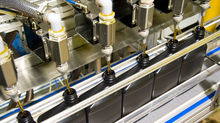Industrial air compressor lubricants - what affects the life of your lubricant?
Whether you are a distributor or an end-user of industrial compressor lubricants, getting the right compressor oil is essential to the equipment life, operating efficiency and up-time optimization. With so many options from which to choose, how can you be sure you are: a) getting the right product, and b) getting the best performance. Here's a few things to consider when analyzing the performance of lubricants, establishing Oil Sampling Program intervals, etc:
1. Discharge Temperature - Any fluid’s service life is halved for every 20°F increase in discharge temperature above 190°F.
2. Ambient - environmental conditions (chemicals, dust) most certainly affects the life cycle change frequency
3. Condition of the compressor - Sludge/varnish build-up
4. Condition of old oil at time of change out (acidity, dirty)
5. Maintenance practices (proper oil level, filter and separator changes)
6. Operating Temperature
Factors that contribute to degradation of a lubricant:
1. Oxidation -
Oxidation will cause a lubricant to degrade in service by a thermally induced reaction with oxygen
The process will speed up by heat, light metal catalysts and the presence of water, acids and solid contamination
Oxidation is a chain reaction. So the further it progresses the more rapid it becomes
Oxidation will increase viscosity and cause the formation of acids and sludge. All which can effect operation and even the life of the compressor
2. (TAN)Total Acid Number
(TAN)Total Acid Number is a measure of the amount of alkaline necessary to neutralize the inorganic acids present within the oil.
A (TAN) test should not be confused with a pH test. Although acids are being produced by the oxidation process, it is not significant enough to alter the oils pH level.
Range of TAN Results
TAN = <0.1 = Indicates a new fluid
TAN = 2.0 = Condemning Limit
3. Demulsibility
Demulsibility is a measurement of a fluids ability to separate from water. A fluid with good demulsibility (40/40/0) @ 40C should readily separate from water, resulting in clear distinctly separate layers of oil and water.
A fluid with poor demulsibility will not easily separate from water often resulting in cloudiness in both the oil and water layers.
Cloudiness in water layer can also indicate possible additive drop out (typically rust inhibitor)
4. Carbon and Varnish Control
Lubricants with excellent carbon and varnish control lead to cleaner operations, and lower repair costs
POE, Diester, and PAG based compressor fluids exhibit good carbon and varnish control
Carbon and Varnish will cause compressor discharge temperature to rise
5. Compatibility
Signs of incompatibility can include:
Combined fluids become murky
Incompatible fluids can cause foaming
Fluids can turn to jell and become very thick
WHAT YOU CAN DO
Look for lubricants that have been formulated to withstand the high temperatures and pressures of air compressors:
Longer fluid life up to 12,000 hours at 200F
Great resistance against water contamination
Compatible fluids available for all OEM, and most aftermarket compressor fluids
No flushing required
Top off compatible
Enhanced cleaning properties
Resistance against carbon and varnish formation
Reduced downtime, maintenance, which reduce costs
Excellent protection against wear
For more information, CLICK THE LOGO below to send us an email.
























